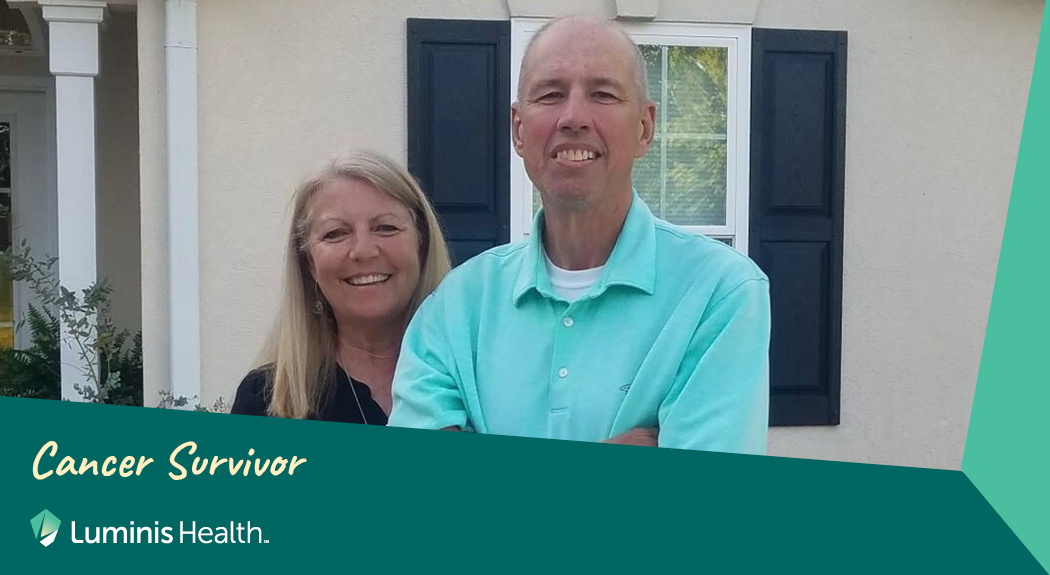Beginning this month – National Cancer Survivor’s Month – we will share a series of blog posts from our own cancer survivors. Each cancer journey is unique. At Luminis Health, we want to shine a light on these journeys from the perspective of our own patients. That’s why we’ve started this new series – bringing hope and comfort to those who have been touched by cancer. Here’s Maureen Disharoon’s story:
Last summer, my husband, Larry, noticed that he had a blister between his toes. We didn’t think much of it, but a few weeks later, it looked a little angry, so we saw a dermatologist—the biopsy came back as melanoma. The dermatologist helped us get an appointment at Luminis Health Anne Arundel Medical Center (LHAAMC) the very next day, which was really kind of amazing. Going through this process during the year of COVID-19 added a challenging layer to this scary scenario.
Over the next few months, Larry had surgery to remove his cancerous toe and a lymph node from his groin. A genetic test recommended by Dr. Adam Riker determined he had a version of the BRAF gene that makes melanoma worse, so he recommended immunotherapy following the surgery. It was a lot, but everything seemed to be going fine until December, when Larry started to have some behavioral and cognitive changes—we learned that the cancer spread to his brain, as well as his lung, his abdomen, and leg. This required an entirely new game plan on very short notice: whole brain radiation and full-blown chemotherapy.
Throughout this process, Larry’s team of doctors at LHAAMC—Drs. Julie Oda, Mary Young, and Adam Riker —were amazing. They were right there at every new development. Dr. Riker always has a “we gotta go after this!” energy, while Dr. Oda has a gentle, caring approach—and both are brilliant. Dr. Young, the radiology oncologist, laid out an aggressive plan the first day she met Larry and moved heaven and earth to set up his whole brain radiation that started hours later…during Christmas week. This was not an insignificant feat. The whole team, including the nutritionist and other staff, gave us whatever we needed; not only did they design a treatment plan for him literally in hours, but everything was so personalized. When he went in for radiation, Dr. Young would occasionally walk Larry out herself and hand him over to me, adding a personal touch to this treatment phase. The staff has just been incredible, compassionate, and accommodating.
From my perspective, as the spouse and advocate, I did a lot of notetaking, scheduling, and orchestrating. I’ve been a NASA consultant supporting many NASA missions for 40 years and this became my newest mission. Most people have seen how quiet and calm mission control is, but in reality, the rooms that surround Mission Control can be frantic. I tried to harness the frenzy, keep out the noise, and focus on the “mission.”
We feel very grateful for the care Larry has received. Larry’s brother died of melanoma at 43, before immunotherapy and other targeted treatments existed. As long as the medicine is working, Larry will stay on it. We know it won’t cure it, but as his doctors say, we can put the cancer to sleep for as long as it will stay asleep. The cancer is asleep now, but if it wakes up—if the gene finds a backdoor, as it’s been known to—then maybe something else will be needed. Larry is still under the care of Drs. Oda, Riker, and Young, and they’re making sure we don’t let our foot off the gas.
But things are hopeful right now: Larry celebrated his 65th birthday in April, and he’s looking and feeling good, he’s gained weight, mows the lawn, and has even gone golfing! If you told me this in February, I don’t know if I’d have believed it. So that’s where we are. We’re enjoying life. Every day we have like this is a win.




